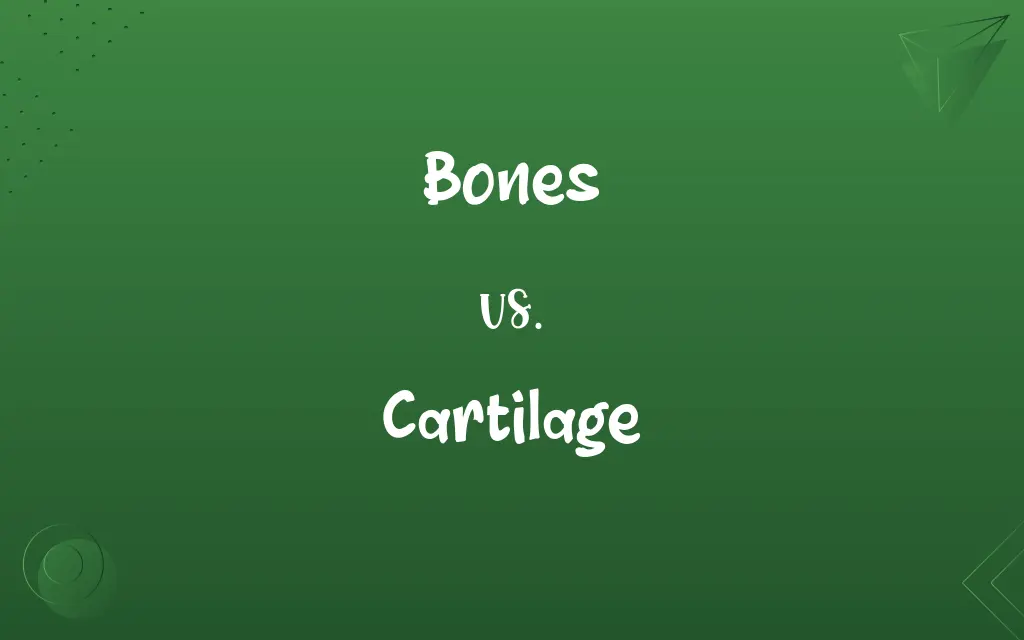Bones vs. Cartilage: Know the Difference

By Shumaila Saeed || Published on January 31, 2024
Bones are hard, rigid structures forming the skeleton, while cartilage is a flexible, rubbery tissue found in joints, ear, nose, and respiratory tract.

Key Differences
Bones, composed of calcium and phosphorus, provide structural support and protection. Cartilage, made of collagen and elastin fibers, offers flexibility and cushions joints.
Shumaila Saeed
Jan 31, 2024
Bones form the skeleton, crucial for movement and organ protection. Cartilage is found in joints, the respiratory tract, and the ear, providing flexibility and shock absorption.
Shumaila Saeed
Jan 31, 2024
Bones have the ability to heal and remodel themselves. Cartilage, however, has limited regenerative capacity due to its avascular nature.
Shumaila Saeed
Jan 31, 2024
Bones undergo a process of growth and mineralization, essential for physical strength. Cartilage serves as a precursor in skeletal development and is replaced by bone in most areas during growth.
Shumaila Saeed
Jan 31, 2024
Diseases like osteoporosis affect bones, reducing density and strength. Cartilage-related disorders include osteoarthritis, where cartilage wears down over time.
Shumaila Saeed
Jan 31, 2024
ADVERTISEMENT
Comparison Chart
Composition
Rich in calcium and phosphorus.
Composed of collagen and elastin fibers.
Shumaila Saeed
Jan 31, 2024
Function
Support, movement, and organ protection.
Flexibility and cushioning in joints.
Shumaila Saeed
Jan 31, 2024
Regenerative Capacity
High, with blood supply aiding repair.
Limited, due to lack of blood vessels.
Shumaila Saeed
Jan 31, 2024
Location in the Body
Forms the skeleton.
Found in joints, ear, nose, and respiratory tract.
Shumaila Saeed
Jan 31, 2024
Disease Susceptibility
Prone to fractures, osteoporosis.
Susceptible to wear and tear, osteoarthritis.
Shumaila Saeed
Jan 31, 2024
ADVERTISEMENT
Bones and Cartilage Definitions
Bones
Bones support and enable movement.
Bones in the leg facilitate walking and running.
Shumaila Saeed
Jan 11, 2024
Cartilage
Cartilage is a flexible connective tissue found in various parts of the body.
The cartilage in the knee joint acts as a cushion during movement.
Shumaila Saeed
Jan 11, 2024
Bones
Bones are rigid organs that constitute part of the vertebrate skeleton.
The femur is the longest and strongest bone in the human body.
Shumaila Saeed
Jan 11, 2024
Cartilage
Cartilage provides structure and shape, especially in the ears and nose.
The shape of the outer ear is due to the flexible cartilage.
Shumaila Saeed
Jan 11, 2024
Bones
The dense, semirigid, porous, calcified connective tissue forming the major portion of the skeleton of most vertebrates. It consists of a dense organic matrix and an inorganic, mineral component.
Shumaila Saeed
Jan 11, 2024
ADVERTISEMENT
Cartilage
Cartilage forms the embryonic skeleton, which is later replaced by bone.
In the embryo, the skeleton initially forms as cartilage before ossifying into bone.
Shumaila Saeed
Jan 11, 2024
Bones
Any of numerous anatomically distinct structures making up the skeleton of a vertebrate animal. There are more than 200 different bones in the human body.
Shumaila Saeed
Jan 11, 2024
Cartilage
Cartilage reduces friction and acts as a shock absorber in joints.
Cartilage in the hip joint prevents bones from rubbing against each other.
Shumaila Saeed
Jan 11, 2024
Cartilage
Cartilage is important for smooth joint movement.
Cartilage facilitates smooth bending of the elbow.
Shumaila Saeed
Jan 11, 2024
Cartilage
A tough, elastic, fibrous connective tissue that is a major constituent of the embryonic and young vertebrate skeleton and in most species is converted largely to bone with maturation. It is found in various parts of the human body, such as the joints, outer ear, and larynx.
Shumaila Saeed
Jan 11, 2024
Cartilage
A usually translucent and somewhat elastic, dense, nonvascular connective tissue found in various forms in the larynx and respiratory tract, in structures such as the external ear, and in the articulating surfaces of joints. It composes most of the skeleton of vertebrate embryos, being replaced by bone during ossification in the higher vertebrates.
Shumaila Saeed
Jan 11, 2024
Bones
Bones Flat clappers made of bone or wood originally used by the end man in a minstrel show.
Shumaila Saeed
Jan 11, 2024
Bones
Vulgar Slang To have sexual intercourse with. Used especially of a man.
Shumaila Saeed
Jan 11, 2024
Bones
A percussive folk musical instrument played as a pair in one hand, often made from bovine ribs.
Shumaila Saeed
Jan 11, 2024
Bones
(informal) The act of two fists meeting together in the manner equivalent to a high-five.
Shumaila Saeed
Jan 11, 2024
Bones
A percussion instrument consisting of a pair of hollow pieces of wood or bone (usually held between the thumb and fingers) that are made to click together (as by Spanish dancers) in rhythm with the dance
Shumaila Saeed
Jan 11, 2024
Bones
Bones provide structure and protect internal organs.
The skull bones protect the brain from injury.
Shumaila Saeed
Jan 11, 2024
Bones
Bones store minerals and produce blood cells.
Bones store calcium, vital for various body functions.
Shumaila Saeed
Jan 11, 2024
Bones
Bones are a framework that gives shape to the body.
The ribcage is a set of bones that protect the heart and lungs.
Shumaila Saeed
Jan 11, 2024
Repeatedly Asked Queries
Is cartilage capable of healing?
Cartilage has limited healing ability due to its avascular nature.
Shumaila Saeed
Jan 31, 2024
Where are bones located in the body?
Bones form the skeleton, providing structure and support.
Shumaila Saeed
Jan 31, 2024
How does cartilage contribute to joint health?
Cartilage reduces friction and absorbs shock in joints.
Shumaila Saeed
Jan 31, 2024
Can bones regenerate?
Yes, bones have a high capacity for self-repair and regeneration.
Shumaila Saeed
Jan 31, 2024
What are the common diseases affecting bones?
Common bone diseases include osteoporosis and fractures.
Shumaila Saeed
Jan 31, 2024
How do bones and muscles work together?
Bones provide leverage and structure for muscles to attach and facilitate movement.
Shumaila Saeed
Jan 31, 2024
What is the function of cartilage?
Cartilage provides flexibility and cushioning in joints.
Shumaila Saeed
Jan 31, 2024
What are bones made of?
Bones are primarily made of calcium and phosphorus.
Shumaila Saeed
Jan 31, 2024
Do bones play a role in blood cell production?
Yes, bones produce blood cells in their marrow.
Shumaila Saeed
Jan 31, 2024
Does cartilage grow back?
Cartilage regrowth is very limited due to its lack of blood vessels.
Shumaila Saeed
Jan 31, 2024
Are there different types of cartilage?
Yes, the main types are hyaline, elastic, and fibrocartilage.
Shumaila Saeed
Jan 31, 2024
What nutrients are important for bone health?
Calcium, vitamin D, and phosphorus are crucial for bone health.
Shumaila Saeed
Jan 31, 2024
What is the role of cartilage in the respiratory system?
Cartilage maintains the open structure of airways like the trachea.
Shumaila Saeed
Jan 31, 2024
How does aging affect bones?
Aging can lead to decreased bone density and strength.
Shumaila Saeed
Jan 31, 2024
Is cartilage stronger than bone?
No, cartilage is more flexible but less strong and rigid than bone.
Shumaila Saeed
Jan 31, 2024
How do bones change throughout life?
Bones grow and remodel themselves throughout life, responding to physical stress and nutritional changes.
Shumaila Saeed
Jan 31, 2024
Can arthritis affect both bones and cartilage?
Yes, arthritis can affect both, leading to joint pain and stiffness.
Shumaila Saeed
Jan 31, 2024
Can cartilage be replaced or repaired surgically?
Yes, damaged cartilage can be surgically repaired or replaced in some cases.
Shumaila Saeed
Jan 31, 2024
What is the primary difference in composition between bone and cartilage?
Bone is rich in minerals (calcium, phosphorus), whereas cartilage is made of collagen and elastin fibers.
Shumaila Saeed
Jan 31, 2024
Are bones and cartilage considered living tissue?
Yes, both are living tissues, containing cells that maintain and repair their structure.
Shumaila Saeed
Jan 31, 2024
Share this page
Link for your blog / website
HTML
Link to share via messenger
About Author
Written by
Shumaila SaeedShumaila Saeed, an expert content creator with 6 years of experience, specializes in distilling complex topics into easily digestible comparisons, shining a light on the nuances that both inform and educate readers with clarity and accuracy.








































































